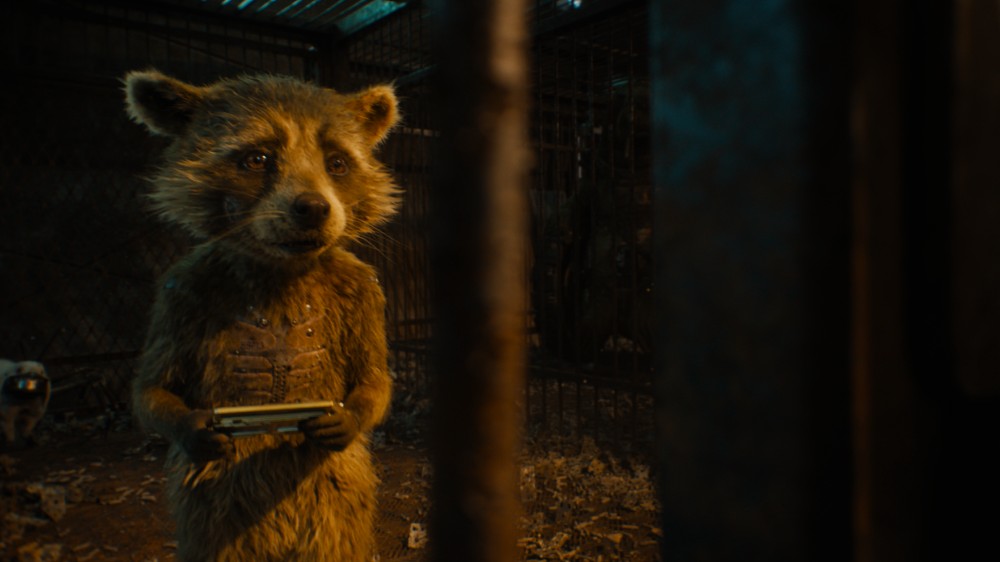
It’s hard to imagine James Gunn‘s Guardians of the Galaxy Vol. 3 without any of its visual effects, because so much of the movie relies heavily on them, whether it’s key characters like Rocket and Groot (voiced by Bradley Cooper and Vin Diesel, respectively) or the team’s enormous Knowhere headquarters, or any of the rest of the movie’s outer space action.
In charge of that aspect of the movie was Visual Effects Supervisor Stephane Ceretti, who previously performed a similar role on Guardians of the Galaxy in 2014 before moving over to Scott Derrickson‘s 2016 Marvel movie, Doctor Strange, both of which Ceretti was part of the teams that received Oscar nominations. To achieve these things, Ceretti used many VFX vendors for the film, including Framestore, Weta FX, Sony Pictures Imageworks, and others.
Below the Line spoke with Stephane Ceretti over Zoom a few weeks back to learn more about what went into bringing Gunn’s latest vision to life, focusing mainly on things like Rocket and his childhood animal friends, but also talking about the tricky aspect of his job in getting competing VFX vendors to work together.
Below the Line: I believe this is your third Guardians movie, and you’ve done a number of Marvel movies in between…
Stephane Ceretti: Actually, It’s my second, because I didn’t do the second one. I did the first one, I did the third one, and I did the Holiday Special, which we did at the same time as the third one, but I didn’t do the second one. It was Chris Townsend who did the second one. I was doing Doctor Strange at the time.
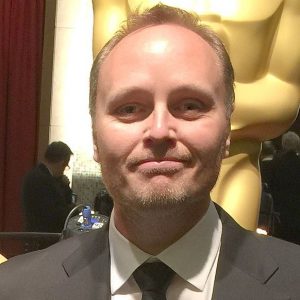
BTL: And you got an Oscar nomination for that, too. You mentioned you did the special, so what was the timeframe for that, and was there a lot of overlap?
Ceretti: Absolutely, because we shot the special pretty much at the same time as we were shooting the film. Some days were for the film and some days were for the special, and then they started editing the special, really, really quick. It was Greg D’Auria, who ended up also being the Second Editor on the film, who was editing the Special, and we had to deliver the Special a little bit before Thanksgiving because that’s when it came out on the service. We had to do 600 VFX shots on top of the 3,000 VFX shots we were doing for the film at the same time. That gave us a good kick. We had a lot of things that we had already worked on.
Obviously, Cosmo was one big stress for us for the special to get done in time, but Framestore Montreal did a really good job on that, and then they were sharing their animation work with Framestore UK. There was a lot of Framestore stuff in the Special, and we also had to build a new Groot. There were a lot of things to do for the special. It was a bit of a rush at the beginning, but that gave us a lot of good information for the film, because there were a lot of elements for the special that we would use for the film after.
BTL: I was convinced that the Groot from the Special was a person in a suit.
Ceretti: I take it as a compliment that people are fooled enough that they can’t tell. It’s interesting because in the Special, there was nothing special about what Groot was doing. He was just there. But when you start watching the film, you understand why that design is so important for us in the film and why it pays off more in the film. That’s why I think people were like, ‘Oh, that could have been a guy in a suit,’ but actually, it couldn’t. The animators at Framestore did a really good job, especially with all the interaction with the actors. There were lots of moments, [like] when they exchange the gifts and when he dances, all that stuff, it was really cool. James did all the dancing for us. He was literally on set dancing with everybody else, and we just animated on top of him and gave it a little bit more weight, painted out James from the plate, and put Groot in there.
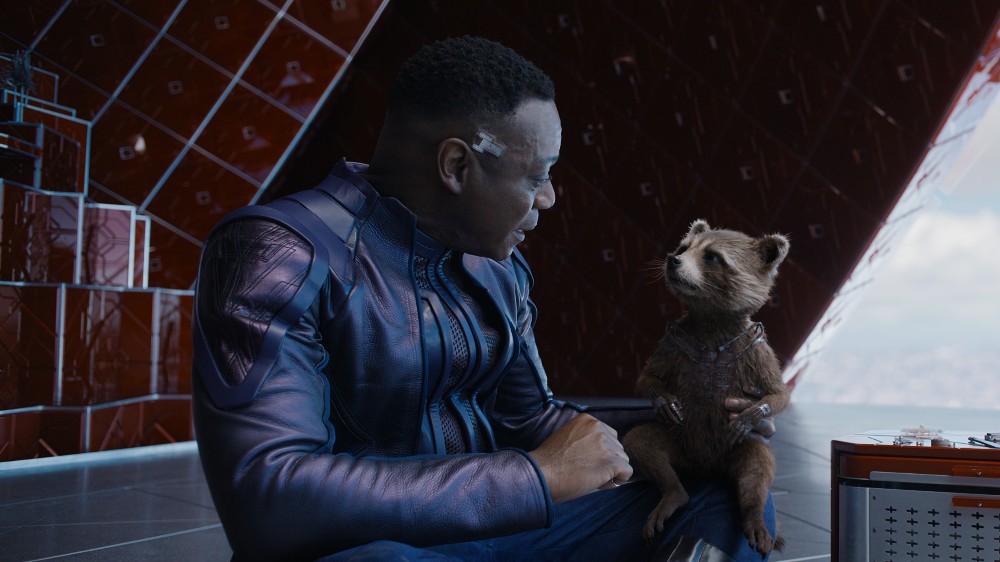
BTL: You don’t use the green suits with the dots anymore, right?
Ceretti: James would never wear that anyways. [laughs]
BTL: But his brother Sean does?
Ceretti: We don’t do it anymore. Sean, he’s just wearing a gray suit. Sometimes, he just wears a yoga suit or something. Now, we animate on top. Most of the time, we just use the clean plates, so we don’t really use the plates where he’s in the frame, but we animate based off him. It’s mostly about the acting and the emotion. For the movement itself, it’s all hand-animated. Everything is hand-animated, the face, the motion, everything. Sean gives us a sense of acting for the tempo, the timing of things. Also, his facial expressions, we’re now pretty good at translating that into the face of a raccoon. It’s really a lot of hand-animation in the end.
BTL: James was very complimentary of Framestore, posting a lot of the animal shots on his social media. Those animals look so real and lifelike.
Ceretti: We started with Framestore on the first film – they did Rocket on the first film. Obviously, it was a shared asset afterward with MPC at the time, but they created the character, in my opinion, in terms of how we would handle it in animation, and everything you would do. We really worked together with James and Framestore and myself on the first one to really establish that character. They really understand him more than anybody else.
That’s why we decided on this one again, after they had also worked on the second one, and now the third one, that they would be telling the story of Rocket. They would be the main vendor in terms of setting the backstory, creating the little kids, and all the story of him growing up in those cages. It was really important for us to go back [to] Framestore and work with them on that – they are so brilliant at these things, and they had a lot of work on this one. If you can imagine the shots where we have so many little raccoons interacting, jumping on top of each other. This is both animator heaven and hell at the same time, because it’s so beautiful and emotional shots, but It’s a lot of work. Actually, I think there were just one or two guys that worked just on the sequences for most of the post-production. They really were in charge of dealing with all those shots with the kids in the cages, then also the [section] where Rocket grabs them to save them, puts them on his body.
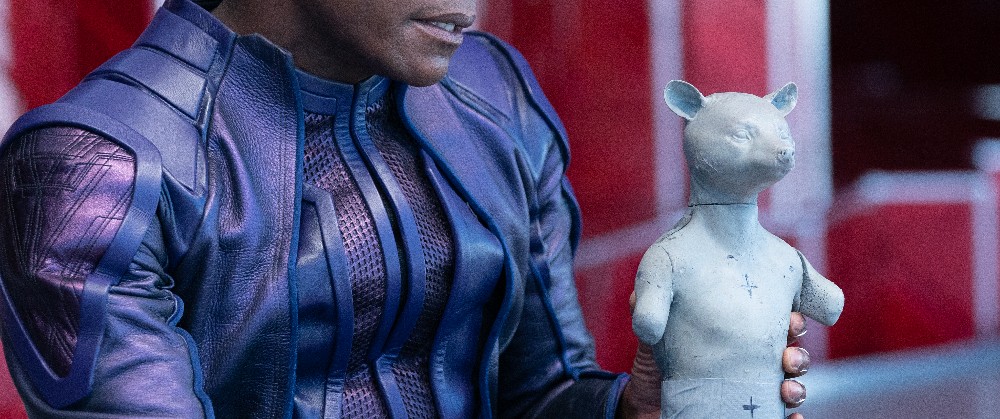
There was a lot of very complicated interaction with fur and things like that. Going back to James and Framestore. James loves Framestore, he loves Weta. I think he started to work with [Weta] on the second one, and then he did The Suicide Squad with them, and he really likes working with Guy and his team. I’ve worked with Weta before. What you could see in this movie and all the vendors coming into it, they already have a love for the characters and the film, and they really liked working with James, because he is a great director, very decisive. He’s written the script, and we haven’t changed the script since prep. It’s been very a very linear process in that way, so it’s very stable as a movie, as a cut. The editors, Fred Raskin and Greg D’Auria, have worked with James for a long time, and we all have worked together to some degree, so it’s been a really good process for the vendors as well, and they all love working on the film.
BTL: It definitely seems like there’s some carry-over from the first movie, so there were a lot of relationships you already had, and not so many vendors were coming on board and having to start from scratch.
Ceretti: In terms of building the assets, we always start from scratch to be honest, because the technology keeps evolving so much between shows that we have to redo some of the assets. Also, the costume change, and we want the characters to evolve. Maybe Rocket is a little bit older there. There were things that happened to the character across all the films he had been featured in, including the Infinity War and Endgame movies and Thor, where they added a few little changes on the model that we looked at again with James, and we decided to go back to some of the original things that we had in the first one to make Rocket a little bit more animalistic, especially with his eyes.
What happened is that film after film, they added more and more white around the iris of the pupil of the eyes, and to me, it made him a little less animalistic doing this. Discussing with James initially, when I came back on the film, I showed him all the different versions of Rocket and how he evolved across time, and we decided to bring back a little bit more of that really two little round black eyes with not much white around the eyes so that it looks really like an animal. We just wanted to make sure you could relate him to the little kids in the cages and to all these animals that are here. He is a raccoon, so when he sees his name on the cage, okay, he is an animal, so you wanted to have that feeling all the time. It got a little bit more humanified in the way across the movies he’s been in, so for me, it was trying to bring that back a little bit.
BTL: What about some of the other creatures like the Abalisks, which Weta did, and there’s another creature, I don’t know what it was called, but it was the cute creature that Adam Warlock seemingly adopted.
Ceretti: Oh, the little Blurp, which was totally out of James’ imagination; Sony did that. It’s kind of a call-back to the first film. I don’t know if you remember, but when they get to Knowhere, and they get to the bar, there’s a F’saki and the rats, and there’s that game they’re playing. In the first film, it was a furless F’saki, and James said that in this film, it would be a furry F’saki. It’s the same kind of body, but this one has fur, and it’s cute, and it’s coming with the Ravagers. He ends up being friendly with Adam Warlock after that crazy scene when he kills the guy in the Orgosphere? It was just to add a member to the team, and it was so funny and cute, and it was giving a little bit of a more human feel to Adam Warlock. The fact that he gets to have a friendship with that animal that got so sad, because of what he had done. That was giving a little bit more depth to the character, I think.
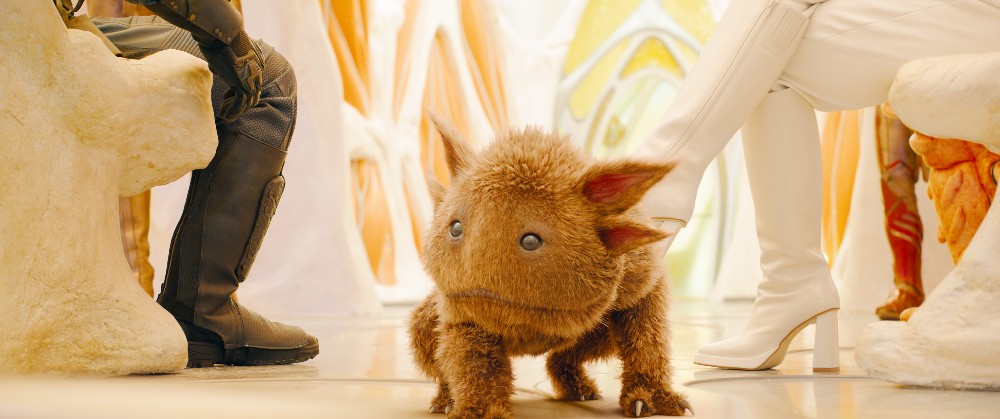
BTL: I’m sure James doesn’t think this way, but I’m sure someone at Disney saw Blurp and thought it would make a great plushie toy.
Ceretti: Weirdly enough, the more we were working with this character, we were like, “Oh my god. This is so freakin cute!’ James billed him as being cute, but I don’t think Disney has made any toys of it yet. We were talking about it. We were even actually making jokes with Weta. Maybe we should get some toys built, and we can make a lot of money out of it. We haven’t done it, and obviously, we can’t, but I’m sure it’s going to happen now. That thing is so cute, it’s fantastic.
We had that. We had the Abelisks, and obviously, all the animals that you see at the end of the film when Rocket escapes, that section with the animals was done with Framestore, all the animals coming out of the cages. They’re all CG animals, and you see them in the scenes in the cages. You see them a little bit in the shadows, but at the end, you’ve got what we call the animal stampede, and it’s these tens and tens of animals running around, and It’s all CG. These were some of the most complicated and render-heavy shots we had to do on the film. One of these shots would take a week to render on Framestore Render Farm.
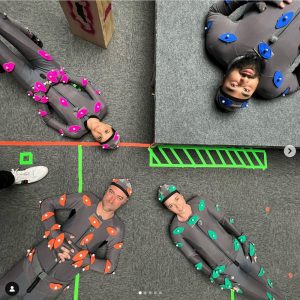
One thing I really liked about the movie is the story of Rocket — how we came back to the origins and also how we shot it. We used what I would call a subset of virtual production for that. All the scenes in the cages, we shot the first two days of the shoot, actually, because we knew we would need a lot of time to get that done in post. It’s the heart of the movie, and there was so much emotion in this, so we have the four actors… obviously Rocket and Lylla and Teefs and Floor, all of them. We created an oversized floor and some bars to separate them, and all of that, the size of the actual cages, which are smaller, because they’re smaller animals than humans.
We had a motion capture environment, but what James wanted is to shoot the scene as he would shoot the rest of the film. The big thing we did was doing motion capture, not on the actors, because we never use motion capture in these movies to animate. We use motion reference, and then give it to the animators. The thing we motion captured was the camera moves. We had three cameras moving at the same time, because we only had two days to shoot all of that, which is about 15 minutes or so. We shot it with three cameras shooting all the time, and we motion-captured all the camera moves. We shot everything with the actors doing all the scenes, so the editors could edit the scene with the right camera angles, so we wouldn’t have to guess the camera angles later in post. James said, ‘I’m going to shoot it my way. I want to shoot it with Henry Braham, our cinematographer, who is also a camera operator, using these little camera rigs and shoot everything like that, so we can edit it later very quickly, and then pass it down to the animators to do their job. We would have the fully built scene that we could look at and evaluate for acting, and also for framing. All of these camera motions, all of this blocking, was recorded, so that we could give it to the vendors, and they could use that as the template really.
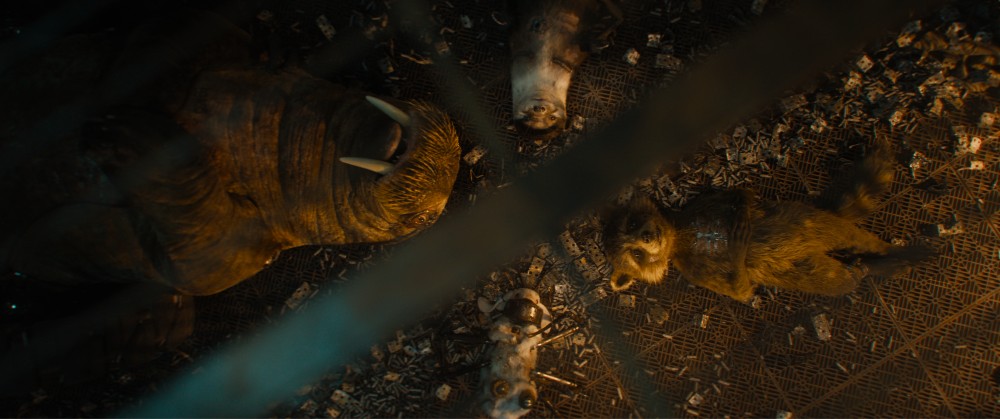
That makes that scene more seamless with the rest of the film, because it is shot by James and Henry, and it is exactly how he wanted to cover it. It gained us so much time not trying to guess how to cover these moments, how to film that. It was really efficient for us in that sense, and we knew we had to nail that really well and get that in the pipeline as soon as possible.
BTL: I was surprised when you said it took a week to render something. Obviously, in the early days of visual effects, there were limitations based on the speed of the computers, but I thought that computers now are so fast and have so much power, that’s no longer an issue.
Ceretti: We keep cramming more and more stuff into them, so whatever happens, even if they go faster, ‘Oh, they can do that much more. Watch my beer. We’re going to put more in it.’ Render times never go down, because we keep adding more stuff, and we keep seeing more and more. We have now realistic lighting with proper balance, all the light treatment, and think about it: all these animals are furry, so they all have fur. This is some of the most complicated renders. Fur was a big thing for this movie, but also, interaction with her and interaction between the actors and the CG characters. In the first film, we did it a few times. One of the most complicated scenes in the first film was just Drax at the end of the film petting Rocket after the death of Groot. It was such a heartfelt moment. That was really complicated already at the time. Now, in this film, we have that happening all the time. There are people hugging with multiple CG characters, and we have Quill trying to revive Rocket, and hugging him with Groot. All these shots are extremely complicated. We have a shot of Gamora at the end with the Ravagers and that red guy with his big ears, and they’re all hugging together, and they’re even touching faces — the CG character and Zoe Saldana. These were all very complicated shots that a few years ago, we would have had trouble making them believable, but now it’s a little bit more straightforward, but it requires a lot of work.
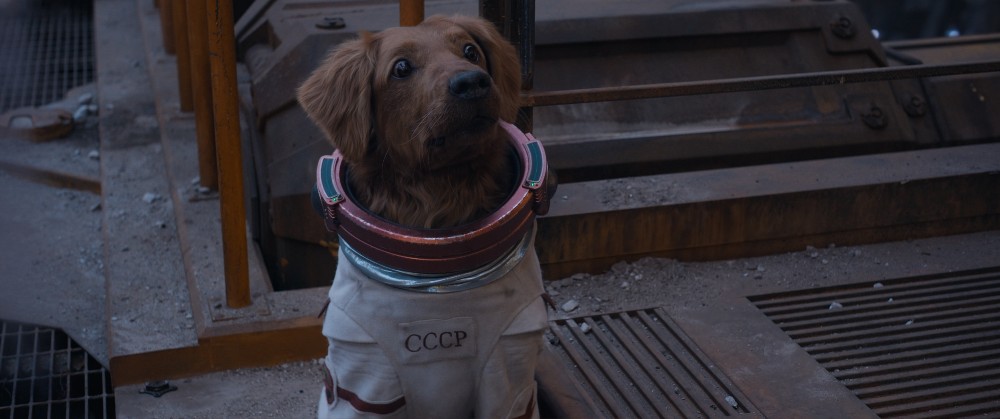
BTL: One of the things I’ve learned from talking to VFX people over the years is that it’s very competitive between the houses as far as the bidding and pitching, but then they all have to work together. At times, do you find yourself having to be the mediator to get them to work well together, or do they all know each other and find ways to do so?
Ceretti: It’s not being the mediator, because everybody knows each other. I mean, it’s not a big world. It’s a small world, actually, and they’ve worked really hard, because those movies are so big. We have 3,000 shots, and we have scenes that use different assets, but Rocket is everywhere, Groot is everywhere. We don’t want to share shots, because you don’t want to have an animation shot where you have one character done by one company, the other one done by another one. What the companies have learned and really developed over the years is sharing assets and sharing effects and stuff like that. It’s not as straightforward as it seems. Most of the time, you can really share a model. You can share a little bit of fur and stuff like that, but every company has [its] own render pipeline, rigging, shading is different. They can exchange textures, but even the way they apply them to their models depends really on the render engine. We do exchange a lot of models, which has been made easier in the last five to seven years. That’s much easier. Before, it was a bit of a pain. Now, It’s pretty straightforward, and they’ve learned to work so well together. I would say there’s no competition. Once you’re on the film, and everybody’s working on the film, there’s no competition. We’re just all trying to make the best movie possible. Everybody’s like, ‘Okay, you need that? Okay, I’ll get it to you. I need this’ or ‘these guys can’t really render this because it’s only for that one shot. Can you do that for them, then they change cameras, layouts, and things like that?’
It’s much more fluid than it used to be, and everybody, especially on these movies, wants to do the best job and help everybody else. We are the control tower. We’re like, ‘Okay, we need this there, and that needs to shift to here. These shots, they were yours, but now that we see the film and the way it’s cut, maybe these should shift to you guys, and you guys are going to take this.’ We’re trying to really balance the load between the vendors and help them get there as fast as possible. It’s a big part our job. My job is both being creative, being the voice of James, also being the conduit between James and the vendors.
I have an open-door policy. I do a lot of meetings with James and the vendors together, so they can talk about things, especially when it comes to animation. To me, it’s like acting, so the director needs to direct the actors, and he needs to direct the animators as well. It’s the same thing. I have really an open door, and we do a lot of meetings with James and the vendors on that front, and James is super savvy with these things. He’s done it for a while now, and he understands what he needs to get out of everybody, and he really is directing the animators the same way he directs the actors. I’m on set with James all the time, and we have the same type of conversation with the animators that he does with the actors. It’s very seamless in that sense. That’s where you get the best performance. He’s extremely good at these things and you get the emotion out of the CG characters, the same way you get it out of the actors. I’m diverging, but yeah, so I have a very creative side but also there’s that very technical, ‘how do we get things done?’ It’s very important to work well with the vendors, all of them, and they will work very well together.
BTL: I spoke to the VFX Supervisor for WandaVision a few years ago, and it was really interesting to hear how different it is doing VFX for a series vs. for a feature-length film. On TV shows, vendors are doing specific things, but it seems like with these Marvel movies, it’s more about each vendor taking long extended scenes or portions of a movie.
Ceretti: The only thing I did [was that] all the end of the movie, when it comes to all the space stuff and the spaceport, the only thing we had to share or switch between Weta and Framestore was the animal stampede, because it was so specific about animals. Obviously, everything that’s happening in the cages in the third act, when Rocket goes and frees the kids, it was all Framestore, but all the rest is Weta. They did a pretty amazing job and they shared Knowhere. Knowhere was done at Framestore Montreal, and it was used at Framestore UK, and then shared with Weta to do the final battle with Craglin using the arrows against all the flying stations. I’m telling you, there are a lot of assets flying around.
Guardians of the Galaxy Vol. 3 continues to play in theaters across the globe courtesy of Disney. Look for our interview with Weta FX’s Guy Williams and Michael Cozens very soon.





